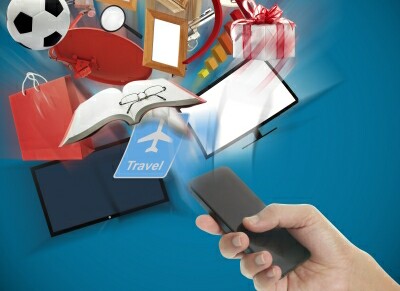Disruption Time, Understanding Connected Consumers Is Critical for Retailers -- Dan Hodges, Consumers In Motion

Here is the challenge for retailers and marketers today.
The consumer’s media consumption and shopping habits are changing simultaneously. How do retailers create awareness, consideration, purchase and loyalty in 2014 using marketing tools developed for a different time? How do retailers harness technology, design, context and real-time intelligence in a way that delights consumers and connects them to their stores and brands? How do retailers and marketers stay informed and up to date about technology and consumer behavior in a dynamic and ever-changing marketplace?
During this past holiday season traffic for brick and mortar retail stores declined by 6.5%*. Are brick and mortar stores in permanent decline? Will shopping malls disappear in ten years? Or, are we entering the golden age of omni-channel retail, where consumers can shop their favorite stores anytime, anywhere? The technology and tools being developed allow brands and retailers to reward their loyal shoppers while enticing new people to shop with them.
Here is how it happened.
A rapid paradigm shift occurred with the introduction of the iPhone in 2007. Nokia (my former employer) developed a similar device five years prior to the iPhone launch but never brought it to market, as they did not believe consumers would respond to touch screens. They missed a huge technology and consumer wave, which resulted in the sale of Nokia to Microsoft several years later for a fraction of its former market value. We are currently in the first phase of a ten-year disruption cycle. Retailers and marketers must recognize the implications of this disruption cycle and act or face a similar fate.
In 2017, the US will be a smartphone dominant market -- and the world will quickly follow once a $25 smartphone is achieved. What makes this time challenging is the successive and simultaneous revolutions in big data, real-time information, advances in location technology and the growing field of contextual awareness. These revolutions will further re-wire the consumers habits and behaviors and impact retailers.
Here is what retailers can do.
Accept change, be a constant learner, understand your consumer and innovate. Let’s take a look at the leaders in location technology as a start.
There is much press about iBeacon trials in Apple Stores, Timberland, Kenneth Cole and Alex and Ani but there are other technologies and different methods to gather location information that are just as innovative. In fact, there are five marketable technologies that use location in stores to help consumers find products and get offers and coupons among other things. The technologies include magnetic, sound, light, image recognition and low energy Bluetooth.
Here are some leaders in location technology.
Magnetic
Indoor Atlas Their approach is to use the unique magnetic properties that exist within every building to create location fingerprint. There is no need for the addition and expense of beacons with Indoor Atlas, as everything you need if already on your smartphone. It does this using the compass chip that’s inside every smartphone. The challenge with Indoor Atlas is each store and location would need to be mapped. The company was founded in 2012 as a spin-off from the University of Oulu, Finland. They incorporated in the US with an office in Mountain View, CA in 2013 -- with R&D centers located in Oulu, Finland, and Oxford, UK.
Sound
Sonic Notify This company uses sound with inaudible mobile notification technology and low energy Bluetooth (BLE) to enable location. They have the technology and a suite of analytics tools needed to understand consumer movements within retail today.
Light
Byte Light Byte Light provides accurate indoor positioning services on any smartphone by using LED lights. The software transforms existing LED lights into location waypoints. The waypoints beam a signal to any smartphone using a camera.
Philips Philips the leader in lighting is piloting an intelligent supermarket lighting system that can help shoppers find their groceries based on their location in the store. The system uses lighting fixtures that form a dense network which acts as a positioning grid. Each fixture is identifiable and able to communicate its position to an app on a shopper’s smart device.
By integrating location services in the lighting system, retailers who want to offer location-based services don’t have to invest in additional infrastructure.
Image recognition and camera
Google Glass This device is a wearable computer with an optical head-mounted display (OHMD) currently sold and in development by Google. The device displays information in a hands-free format that communicates with the Internet via natural language voice commands.
Bluetooth Low Energy (BLE) Bluetooth low energy technology extends the use of Bluetooth wireless technology to devices that are powered by small energy efficient batteries. Smartphones produced today come with low energy Bluetooth that makes this an attractive technology.
iBeacon This is a new technology that extends location services in iOS. The iOS device can alert apps when the device owner approaches or leaves a location with an iBeacon. In addition to monitoring location, an app can estimate your proximity to an iBeacon (for example, a display or checkout counter in a retail store). Instead of using latitude and longitude to define the location, this technology uses a Bluetooth low energy signal, which Apple devices detect.
Does location technology drive sales?
The early results on location targeting are promising. Approximately 80% of smartphone owners said they would use retailer apps more often while shopping in a store if those apps delivered sales and promotion alerts**. Additionally, 62% said they would increase their use of retailer mobile apps in the store if the apps provided content that was more relevant to their interests and location**.
Media mogul Rupert Murdoch offers good advice as it relates to retailers: “The world is changing very fast. Big will not beat small anymore. It will be the fast beating the slow.”
Sources: *Retail Next, December 2013 Study, **2013 December study from Research Now:
Note: Consumers in Motion is releasing “Using Context to Reach Tomorrow Shoppers” in May 2014.
Please sign up for this report, weekly updates and industry analysis from Consumers in Motion.
Dan Hodges is Managing Director of Consumers in Motion, LLC. Dan can be reached at dan@consumersinmotion.com
dan@consumersinmotion.com
Read all Dan's MediaBizBloggers commentaries at MediaBizBloggers Guest Blog.
Check us out on Facebook at MediaBizBloggers.com
Follow our Twitter updates at @MediaBizBlogger
The opinions and points of view expressed in this commentary are exclusively the views of the author and do not necessarily represent the views of MediaBizBloggers.com management or associated bloggers. MediaBizBloggers is an open thought leadership platform and readers may share their comments and opinions in response to all commentaries.


